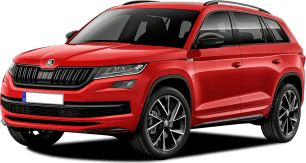It's confusing when it comes to pricing for the 2022 updated Skoda Kodiaq range. Back in August 2021, there was a pricing announcement, and then there were some effects of the semiconductor shortage that meant some items were unavailable. And now, the full-fat Kodiaq range is back on stream, but just take note - there are still de-specced cars on showroom forecourts, so check you're getting what you want when you go shopping.
Prices are up a bit compared to that original 2021 announcement, with the line-up consisting of the following models: the entry-level Style, which is $52,990 drive-away (the equivalent base model was previously $49,490 drive-away); the mid-spec Sportline, which is $57,990 drive-away (up $4000); and the top-spec flagship RS, at $74,990 drive-away (same as before, but now with less grunt - more on that in the engines section).
The Style grade is $3500 more than the previous base model, but it opens the range with a bunch of nice inclusions - 19-inch alloy wheels, LED headlights and DRLs, roof rails, keyless entry and push-start, the ‘virtual cockpit' digital instrument cluster, a 9.2-inch multimedia display with wireless Apple CarPlay and Android Auto, privacy glass, ambient interior lighting, dual-zone climate control, a wireless phone charger and USB-C ports.
There is also proximity unlocking for all doors, an electric tailgate, tinted rear glass, integrated rear window shades, and those clever touches we've come to expect from Skoda, including an umbrella in the driver's door, a picnic mat under the boot floor, and cargo netting, too.
According to Skoda, customers who buy the Style model are likely to choose either (or both) of the available option packs.
First is the Tech Pack ($3000) that includes adaptive suspension, drive mode selector, an off-road mode, auto parking assist, 12-speaker sound system, gesture-kick tailgate and the Sleep Package (extended rear headrests).
Then there's the Luxury Pack ($6500) that adds Matrix LED headlights, electrically adjustable front seats with memory settings, Ergonomic seats, perforated leather upholstery, heated front and rear seats, heated steering wheel with paddle shifters, three-zone climate control, auto-folding door mirrors, and a few safety items that really should be standard at this price point: blind-spot monitoring, rear cross-traffic alert, active lane keeping assist and a surround view camera, among other things.
Choose the Sportline at $57,990 and your extra five grand buys you some stuff you'll be happy to have, including 20-inch wheels, Matrix LED headlights with adaptive beams and auto high-beam, Alcantara and leather seat trim, electric driver's seat adjustment with memory settings, a progressive steering setup (sportier steering), fog-lights with cornering function, and the Sportline exterior styling pack with additional colour-coding and black highlights, and a drive mode select system. The interior headlining is black, too, and it has Alcantara trim on the doors, and a different plastic trim finish as well.
Again, you can choose the Tech Pack ($3000) as above, or the Luxury Pack ($3700) which adjusts for a few standard items fitted to the Sportline grade, but again, none of that aforementioned safety stuff you should have standard.
In both the Style and Sportline trim levels, there's also the option of a panoramic glass roof ($1900) and the Sportline also has the choice of leather seat trim with ventilation ($1900).
Then there's the RS - no packs or optional extras available for it - as it gets the full flex of active safety equipment as well as unique aero-inspired 20-inch wheels, all the stuff you'd get if you optioned either of the other grades up with the packages, plus specific interior trim with quilted leather with red contrast stitching, carbon-look plastic, and that new petrol engine with more power and torque than the lower grades. More on that below.
Colours that are no cost include Energy Blue (Style only), Steel Grey (Sportline and RS only); then there's the metallic Moon White, Lava Blue (Style only), Race Blue (RS only), Graphite Grey, Brilliant Silver and Magic Black pearl - these ones cost you $770; and the $1100 Velvet Red premium paint, which is on Sportline or RS only.






.png)
























.png)

















